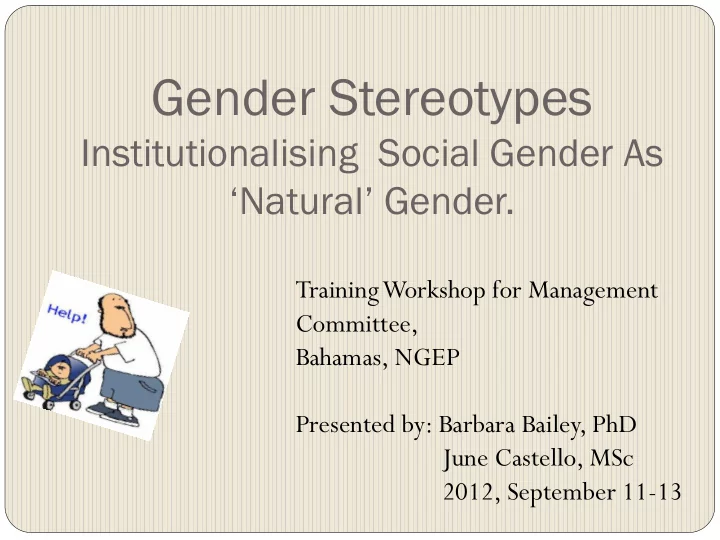

Gender Stereotypes Institutionalising Social Gender As ‘Natural’ Gender. Training Workshop for Management Committee, Bahamas, NGEP Presented by: Barbara Bailey, PhD June Castello, MSc 2012, September 11-13
Gender Stereotypes
Gender Stereotypes … Suga gar r and spice ice and everyth ything ing nice, e, slugs gs and snai ails ls and puppy py dogs’ tails….. A stereotype is defined as ‘a term used to define all people of a certain belief into a mostly negative category that may only reflect a selected few of the racial demographics. All people of all nationalities have been victims of being stereotyped, even those whom have made most of the stereotypes of other people.’ ( www.urbandictionary.com )
Gender Stereotypes A stereotype is used to categorize a group of people. In an attempt to understand that ‘type’ of person, society puts them into classifications, assuming that everyone who is a member of the classified group has certain distinguishing attributes or that anyone who has this combination of attributes, is a member of the group. Gender stereotypes, then are used for categorizing men and women, the masculine and the feminine.
Gender Stereotypes Gender Stereotypes are maintained through a variety of ways: Media (as in advertising and movies etc.) General repetition until they become accepted as the norm Sanctions being applied to those who do not walk the straight and narrow
Gender Stereotypes
Gender Stereotypes Men discuss; women gossip. Women are emotional and cry; men get angry in the face of disrespect. Women’s change of moods is governed by their cycle; men reserve the right to change their position on a matter as circumstances necessitate this. Women love to shop; men hate shopping. Parenting comes more naturally to women than it does to men.
Gender Stereotypes While media has the potential to transform gender images and help in disrupting gender stereotypes, too often media representations of men and women normalise stereotypical gendered behavours. In doing so, media houses do a disservice to men and women by conveying the impression that the hegemonic representations of masculinity and femininity, as well as, the power vested in each, are the exemplars.
Gender Stereotypes Gender roles and stereotypes are the pillars of gender socialisation. Through them, boys and girls are assigned the norms, roles, expectations and social spaces for male and female identity. (http://www.qec- eran.org/network/genderstereotypes.pdf)
Gender Stereotypes: Hard to Resist Informally, by virtue of living in a social world, individuals learn the appropriate or expected gendered behavior for their sex. While individuals can accept or resist traditional gender roles in their own presentation of self, gender roles are a powerful means of social organization that impact many aspects of society. For this reason, individuals inevitably internalize conventional and stereotypic gender roles, irrespective of their particular chosen gender, and develop their sense of gender in the face of strong messaging about the correct gender role for their perceived body. (Johnson and Repta, http://www.sagepub.com/upm-data/40428_Chapter2.pdf)
Gender Stereotypes: How They Work The general repetition of appropriate gendered behaviours and gender roles, together serve to convey the impression that this is the way things are, the way they have always been and will be. Gender roles can be described as social norms, or rules and standards that dictate different interests, responsibilities, opportunities, limitations, and behaviors for men and women. Gender roles structure the various “parts” that individuals play throughout their lives, impacting aspects of daily life from choice of clothing to occupation. These norms convey the false message that the normative is the natural.
Gender Stereotypes
Gender Stereotypes In fact because the gender stereotypes are treated so much as a ‘given’, ideologically and materially, the society organises its structures and services to accommodate these understandings.
Gender Stereotypes In fact because the gender stereotypes are treated so much as a ‘given’, ideologically and materially, the society organises its structures and services to accommodate these understandings .
Gender Stereotypes: Questions for Consideration 1. In spite of the changes in our societies, how seriously has the male breadwinner notion been dislodged? 2. Would men in the Commonwealth of the Bahamas want to hold jobs alongside women? 3. Would Bahamian society accept being cared for by both men and women?
Gender Stereotypes: Questions for Consideration 4. How do we get to the point where we accept men as being strong and allowed to show emotional distress? 5. How do we get to the point where we accept that in spite of women bearing children and being perceived to be vulnerable, they are still equal strong partners of men?
Recommend
More recommend